| کد مقاله | کد نشریه | سال انتشار | مقاله انگلیسی | نسخه تمام متن |
|---|---|---|---|---|
| 1035333 | 1483895 | 2016 | 7 صفحه PDF | دانلود رایگان |
• We study demographic changes of Northwest Patagonian populations along Holocene.
• We combine mtDNA sequences and calibrated radiocarbon dates corrected by taphonomic bias.
• Population size was stable at earlier Early Holocene and increased by 7000 years BP.
• Curves based on corrected radiocarbon and molecular data show a similar pattern.
Studying demographic changes in past human populations is of great interest due to their role in processes of cultural change as well as the biological evolution of populations. Despite this, a general consensus about the most adequate methodological approach to this end is still lacking. Here, a new approach that combines radiocarbon frequency distributions —uncorrected and corrected by taphonomic bias— and demographic curves independently estimated with modern mitochondrial DNA (mtDNA) is used to estimate population size changes in Northwest Patagonia since the Pleistocene–Holocene transition to recent times. Results based on mtDNA sequences suggest a census size of approximately 3000 individuals (with an estimated female effective size of ca. 750 individuals) by the initial peopling of this region around 10,000 years ago. A strong correspondence between curves based on mtDNA data and those based on archaeological radiocarbon dates (n = 251) was obtained after the effect of taphonomic bias was accounted for. The demographic curves indicate that the population size was relatively stable during the earlier Early Holocene and it increased between 7000 and 5000 years ago, reaching a maximum size around 1000 years ago. Then, the population size declined until present time. We conclude that demographic inferences made on the basis of radiocarbon dates are not necessarily biased but this needs to be evaluated with independent evidence in each specific geographical region.
Journal: Journal of Archaeological Science - Volume 65, January 2016, Pages 154–160
